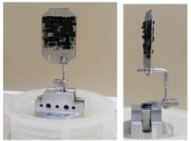•  Physics, chemistry, nanoscience and materials around large instruments › Thématiques NFMQ : magnétisme, transitions de phase - Etudes par diffusion de neutrons
Physics, chemistry, nanoscience and materials around large instruments › Thématiques NFMQ : magnétisme, transitions de phase - Etudes par diffusion de neutrons  Matériaux des nouvelles technologies pour l’énergie
Matériaux des nouvelles technologies pour l’énergie  Physique, chimie, nanosciences et matériaux autour des grands instruments
Physique, chimie, nanosciences et matériaux autour des grands instruments
• Laboratoire Léon Brillouin (LLB) • Leon Brillouin Laboratory (LLB)
• Nouvelles frontières dans les matériaux quantiques - NFMQ
• Neutrons • Activités instrumentales nationales et internationales du LLB - National and internatonial instrumental activities at the LLB • Neutrons • Inelastic scattering



Universality of q=1/2 orbital magnetism in the pseudogap phase of the high-Tc superconductor YBa2Cu3O6+x
Dalila Bounoua, Yvan Sidis, Martin Boehm, Paul Steffens, Toshinao Loew, Lin Shan Guo, Jun Qian, Xin Yao, and Philippe Bourges, Phys. Rev. B 108 (2023) 214408.
Several decades of debate have centered around the nature of the enigmatic pseudogap state in high-temperature superconducting copper oxides. Recently, we reported polarized neutron diffraction measurements that suggested the existence of a magnetic texture bound to the pseudogap phase [Bounoua et al. Commun. Phys. 5, 268 (2022)]. Such a magnetic texture is likely to involve the spontaneous appearance of loop currents within the CuO2 unit cells, which give birth to complex correlated patterns. In the underdoped YBa2Cu3O6.6, the magnetic structure factor of such an orbital magnetic texture gives rise to two distinct magnetic responses at q=0 and q=1/2. As this pattern alters the lattice translation invariance, such a state of matter could contribute to an instability of the Fermi surface. Here, we report polarized neutron scattering measurements on a nearly optimally doped high-quality single crystal of YBa2Cu3O6.9 that exhibits the same q=1/2 magnetism and a weakly overdoped YBa2Cu3O7 sample where this signal is no longer sizable. The in-plane and out-of-plane magnetic neutron scattering intensities in YBa2Cu3O6.9 (at q=1/2) and YBa2Cu3O6.85 (at q=0), reported previously, display the same temperature-dependent hallmarks. The magnitudes of both q=0 and q=1/2 magnetic signals further exhibit the same trends upon doping in YBa2Cu3O6+x, confirming that they are likely intertwined.



